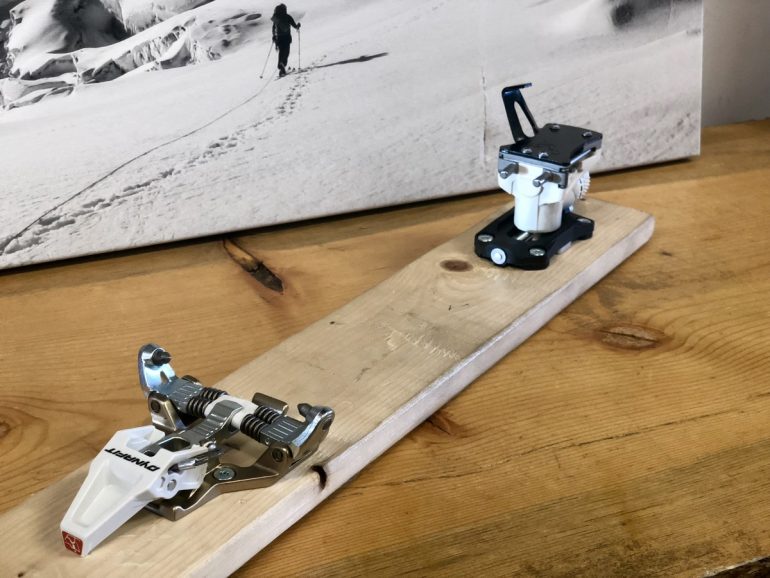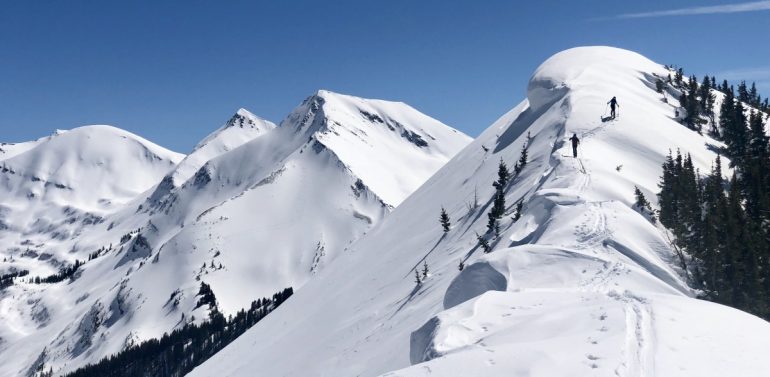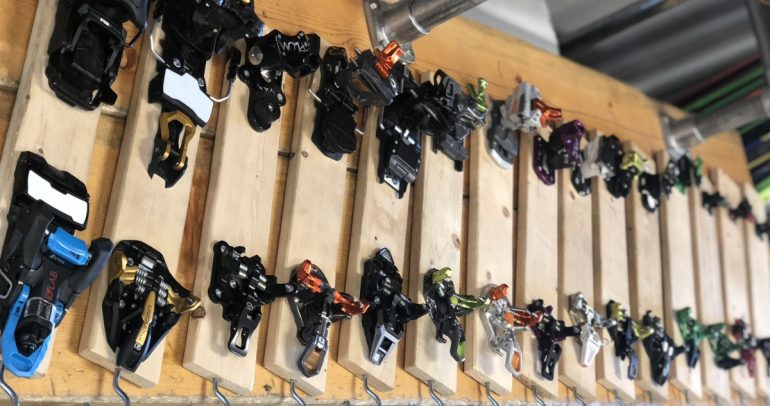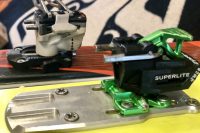Ok: you know you want to be a ski tourer, or you’re totally hooked and thoughts of touring consume your every waking moment. Either way, bindings are one of the techiest pieces of equipment that let you float up the hill and zoom down, so there are a few helpful things to know when buying your next set.
Since tech bindings first hit the market in the early 90s, the industry has progressed in leaps and bounds. Today there are as many varieties of tech bindings as there ice cream flavors in a Upstate New York roadside stand. They share a similar basic concept, but with variations in ingredients and add-ons to suit the evolving needs of the modern ski tourer.
In the short two years since Lou published his extended list of binding buying tips, plate bindings have cried uncle and nearly every binding manufacturer has gone tech. In North America, touring binding pioneer Dynafit keeps company with G3, Diamir and historically alpine binding gurus Marker, Atomic, and Salomon. They’re joined by more obscure brands like Plum, ATK, Ski Trab and Kreuzpitze. That said, all manufacturers are making great systems, and each have their own valuable contributions to the evolution of the tech binding.
But with so many great options, how is the discerning skier to choose? Our first Tuesday Tech Tips is centered around jargon and features to help you develop a basic understanding of your touring tech bindings.
1. Choose a binding with good, regional customer service
With every conceivable tech binding available under your online fingertips, it’s tempting to go for the latest and greatest binding and be the first one on the block to order them from halfway around the world. Although having a rare binding to match your new skis will look cool, warranty and customer service support is important. If your binding breaks in January your FOMO could go through the roof if you are waiting weeks for a new part from Europe, or vice versa if you live across the ocean from North America.
For the United States market, companies like Dynafit and Fritschi (through Black Diamond distribution) tend to have the fastest and most thorough support. Canadian brand G3 also proves reliable, but can take a little longer to get pieces to your door or local shop in the US. If your HQ is located in Western Canada, you could expect an even faster turn around from them. Newer players on the scenes Atomic and Salomon are currently slow and a bit short on replacement inventory, but once they catch up to the new, huge demand, we anticipate their customer service to catch up as well. Plum and ATK are expanding their presence in the United States and so will their speciality shop network of service centers. Without a distribution company within the United States support from companies in Europe will remain limited here, but if you are located in France or Italy expect the North American companies to be a bit slower.
2. Be careful when buying used bindings
With great low price comes great elevated risk. If you find a binding from a swap or classified listing, look it over very carefully before pulling the trigger. If the binding is an older model (no longer in production; this is easy to check on the manufacturer’s website), you can bet it’s out of warranty. If a binding sustains a hard crash or gets dropped, micro-cracks in the plastic casing can form, which can be nearly impossible to see even on close inspection. Given that it’s a bit magical ultralight bindings hold you to a ski at high speeds in various conditions, it’s best to not push your luck on a potentially compromised system.
3. Understand Release Value
For the purpose of this guide throw out the acronym DIN and replace it with RV for Release Value. The lightest race and fitness bindings will have a fixed or non-adjustable release value. This is suitable if you find a binding that has the correct release value based on your weight, but for the newer ski tourer, we recommend a binding that’s adjustable. Check here to get an idea of what your release value should be set to. In general, lighter skiers or newer skiers that typically take crashes at slower speeds will want a lower release value. If you are at the lowest end of this spectrum, look for a binding with a specialized low RV range like the Dynafit Rotation 7 or the Plug Guide XS. If you weigh 200lbs+ or come from an alpine racing background, check out a binding like the Dynafit Rotation 12 or a Marker Kingpin, which has a RV to 13 to really nail you to the ski.
4. Coordinate your riser heights with your cuff articulation
Cuff articulation–the range of motion in your boot–should be inversely correlated to the number of risers on your binding. Older, more freeride oriented boots like the Scarpa Freedom RS and its 25 degrees of cuff articulation need a little help from binding riser heights to compensate for the position they hold your ankle in. Having a flat mode lets you take a more natural stride on lower angle terrain and a high riser setting keeps your calves from blowing out on the steeps. Newer boots like the Dynafit TLT8 have 60 degrees of range of motion and you could get away with two riser heights or sometimes even one fixed riser before you are uncomfortable. Less risers mean less weight and one less thing to fiddle with on your climbs.
5. Why boot sole length adjustment is important
Some very lightweight bindings like the Dynafit Speed Superlight (or nearly every race binding) have no room for adjustability to accommodate different boot sole lengths. If you only have one pair of boots, or only one boot to use with a specific ski setup, this might not matter to you. However, you also have to intend to never change boots for the future of the ski.
Although it is not impossible to add an adjustment plate or remount the ski later on, it is definitely easier to take this into account for the first mount. The Dynafit Speed binding is almost as light as the Superlight, but has 10mm of adjustment. This gives a good shot at switching boots down the road if the boot sole lengths are close. Bindings like the Salomon MTN/Atomic Backland have 30mm of adjustability and will easily accommodate even the biggest discrepancy between two models of touring boots in the same size.
6. How to decide: ski brakes vs. safety leashes
Going with leashes as opposed to brakes has some appeal. Leashes are lighter and cheaper and make it way easier to pull skins with your boots still in the bindings (especially if your skis have a tip notch like most lighter-weight skis). You also have a much better chance of finding your ski if it is attached to your leg than if it is buried deep in the powder with the brakes deployed. However, leashes only have a chance to stop your ski if you clip them and they don’t work at all if you don’t. Their effectiveness is 100% user determined. Make sure you have the personal discipline to always clip your leashes before you go chasing after your ski as it careens down a mountain (believe me, we’ve been there and it can ruin a ski day quick).
It’s also way easier to step into your ski with ski brakes. This luxury you may have taken for granted when switching over from a braked binding will quickly become apparent on top of an icy, wind-hammered peak.
7. When to gram count and when not to
A binding like the Salomon Shift has received a lot of praise, but at 865 grams it is quadruple the weight of a binding that will meet the needs of the majority of ski tourers. If you are less than 200lbs and don’t come from a downhill race background save the weight and look to lighter options. However, when you start splitting hairs over 50 grams of weight saving, it’s better to buy a binding based on the tips above than on weight savings alone.
8. What you should expect to pay for a good touring binding
Brand new touring rigs can cost as little as $350 for fully modern and proven bindings like the Dynafit Speed Turn, or as much as $729 for a new Marker M-werks Kingpin. If even the low-end price seems expensive, we have seen these bindings last for a decade or more of hard use, so amortize that out over those ski seasons and know it’s money well spent.

The Dynafit Speed Turn still closely resembles the first Dynafit bindings and probably still has one of the lowest fail rates of any model in modern production
9. Saving weight means cutting features, but not always
In general you pay a weight penalty for the added bells on a binding. Stripped down superlight bindings will lack the aforementioned boot sole accommodations, brake choice, riser height options and release value settings, but there are a few outliers. At 280 grams (without screws or brakes) the Dynafit Speed binding has it all, even if the size adjustment mentioned above is limited to 10mm. At 296 grams, the Salomon MTN binding is another favorite, but with its increased range it loses the ability to micro adjust release values and you have to settle for a low, medium and high U bar. At a confirmed 374 gram weight with mounting screws and without brakes the G3 Zed will be one of the lightest bindings that does not compromise on any of the big features.
10. Understand the limitations of a tech binding
While many skiers (this author included) routinely double dip their tech bindings on piste, it places an enormous amount of wear and tear on a binding not designed specifically for repeated thrashing day in and day out. Like rallying your new sports car with an 8-inch clearance to every trailhead, you may make it there, but not without some compromising bumps and scrapes on the way. You will also need to spend some added time communing with your tech bindings to know the ins and outs of why they may ice up and what to do with it, but all that’s to come in a future Tech Tuesday.
To choose your tech binding, begin with its intended use. Then consider the specific functions of each binding to narrow it down within that range. If you decide that you don’t need every binding feature or want to use a binding slightly different than its intended purpose, go for it! Just remember that you are making small sacrifices one way or the other.
Looking for ways to troubleshoot your binding or want more info and gear banter? Check back every Tuesday. Have some of your own tips? Share them in the comments below and we might just bump them above the fold.
Doug Stenclik is an avid skimo racer and ski mountaineer who lives for sharing the amazing sports of ski touring and splitboarding. Since his first time on skins he was hooked and the obsession has taken him all over the United States and the world pursuing the human powered ski turn. He founded Cripple Creek Backcountry in 2012 and took over the Colorado Ski Mountaineering Race Cup in 2014 to spread knowledge and the love of the sport. In 2019 he took a step back from the ski shop and race promoter life to become a publishing partner with WildSnow.



